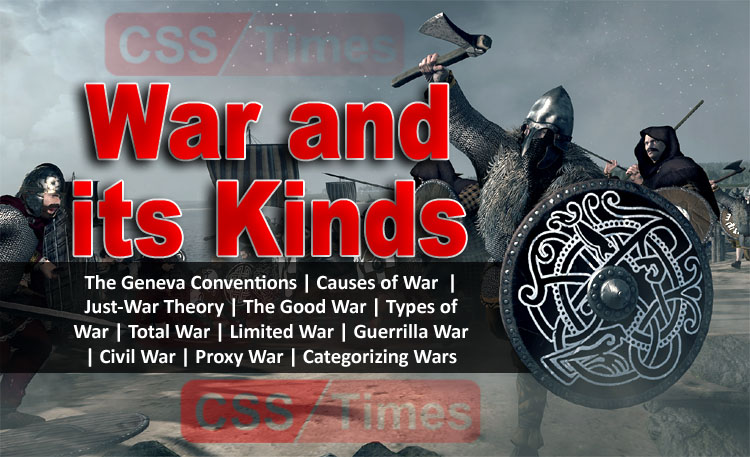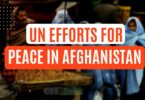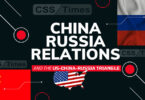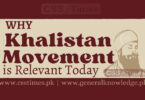War and its Kinds | CSS International Relations / Current Affairs
The Geneva Conventions
In 1864, several states created an international agreement that regulated acceptable behavior during war and armed conflicts. Since then, the Geneva Conventions have been amended in 1906, 1929, and 1949 as the nature of war and warfare has changed. The agreements prohibit torture, rape, genocide, mutilation, slavery, and other crimes against humanity. The conventions also state that prisoners of war must be treated humanely and that civilians may not be used as hostages.| CSS International Relations
Causes of War
Political scientists have long debated the causes of war. These scholars have come up with the following list:
Human nature: Humans are naturally violent and aggressive, making war inevitable.
Regime types: Some regimes are more prone to waging war than others.
Ideology: Some political beliefs favor war more than others. Some scholars blame fascism, for example, for World War II.
Religion: Religious belief has driven many states to war, either to spread the faith or to eradicate heretics.
The global system: Because the global system is anarchic, states must engage in war to protect themselves.
Economics and resources: Disputes over resources often lead to war. CSS International Relations
Just-War Theory | CSS International Relations
Debate has raged as long as wars have been fought as to whether a war can be morally just. Some prominent thinkers have proposed a just-war theory, which argues that wars should be fought for noble and worthwhile reasons. Just-war theorists also try to establish ethical rules for warfare. Of course, whether any war is justified is almost always a matter of debate. But most just-war theorists agree on some basic ideas:
Check Also: National Interest of Pakistan | Definition of National Interest
- War must be the last option. All peaceful means to resolve the conflict must be exhausted before war breaks out.
- The cause of the war must be just (such as overturning aggression and righting a great wrong).
- The war must be winnable.
- The war’s purpose must justify the cost in money and lives.
- The military must make every effort to prevent or limit civilian casualties.
“The Good War” | CSS International Relations
World War II is one of the few wars that nearly everyone believes was morally justified. Nazi Germany and Japan were dangerous regimes that committed atrocities against conquered peoples, and many nations felt that they needed to be stopped. For these reasons, some refer to World War II as “the good war.” In contrast, the social and political turmoil caused by the Vietnam War was based, in part, on debate over whether that war was justified.
Types of War | CSS International Relations
Although all wars are violent, not all wars are the same. In fact, there are many different types of wars, which can be classified according to which people actually fight, the intensity of the conflict, and the extent of combatants’ use of violence, among other factors. CSS International Relations
Scholars generally describe five types of war:
- Total war
- Limited war
- Guerrilla war
- Civil war
- Proxy war
Total War
A total war is a war in which combatants use every resource available to destroy the social fabric of the enemy. Total wars are highly destructive and are characterized by mass civilian casualties because winning a total war often requires combatants to break the people’s will to continue fighting. World Wars I and II were total wars, marked by the complete destruction of the civilian economy and society in many countries, including France, Germany, the Soviet Union, Italy, Great Britain, and Japan.
Limited War
A limited war is a war fought primarily between professional armies to achieve specific political objectives without causing widespread destruction. Although the total of civilian casualties may be high, combatants do not seek to completely destroy the enemy’s social and economic frameworks. The Persian Gulf War of 1990–1991 was a limited war in which the United States and its allies forcibly removed Iraqi troops from Kuwait.
Guerrilla War
A guerrilla war is a war in which one or both combatants use small, lightly armed militia units rather than professional, organized armies. Guerrilla fighters usually seek to topple their government, often enjoying the support of the people. These wars are often very long but also tend to be successful for the insurgents as evidenced by Mao Zedong’s victory over Chiang Kai-shek in China in the 1940s, the Vietcong’s victory over the United States in the Vietnam War, and the Mujahideen’s victory over the Soviet Union in Afghanistan in the 1980s. CSS International Relations
Civil War
A civil war is a war fought within a single country between or among different groups of citizens who want to control the government and do not recognize another group’s right to rule. Civil wars are almost always total wars because each side feels compelled to destroy the enemy’s political support base. Regional rifts, such as the American Civil War between the North and the South, characterize some civil wars, whereas other civil wars have been fought among ethnic rivals, religious rivals, and rival clans. Revolutions can spark civil wars as well. CSS International Relations
Proxy War
A proxy war is a war fought by third parties rather than by the enemy states themselves. Many of the militarized conflicts during the Cold War, such as the Korean War and the Vietnam War, can be interpreted as proxy wars between the United States and the Soviet Union, neither of which wanted to fight each other directly. CSS International Relations
Categorizing Wars
A war can often be a limited war, a guerrilla war, and a civil war all at the same time. The Soviet invasion of Afghanistan in 1979 is a great example. The United States sent trainers, money, and weapons to Afghan rebels to fight against the invaders, making it a low-intensity, limited conflict from the U.S. point of view. The Afghan resistance mostly relied on guerrilla tactics. And the war split Afghanistan, so it was also a civil war.
Follow our Facebook Page for daily updated materials >> CSS Times







